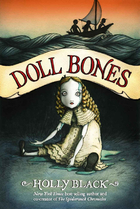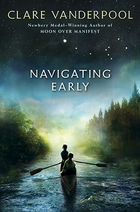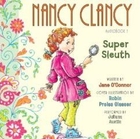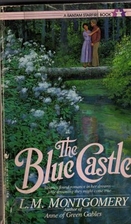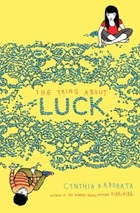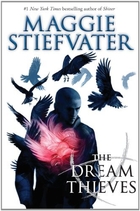I wasn't saving Doll Bones by Holly Black to review on Halloween, but since the day is here and I need to review the book, I can't pass up the opportunity to do so!
Zach, Poppy, and Alice have been playing an imaginative adventure game with dolls and action figures for a long time. In the back of his mind, Zach knows that the game can't go on forever, and now that they're in middle school, he really doesn't want his school friends to know that he still plays with dolls -- but he also doesn't want the game to end. But when Zach's father throws away Zach's bag of action figures in an attempt to get him to grow up, Zach calls an end to the game rather than admit that his characters are gone. Poppy, in a desperate attempt to keep the game going, convinces Zach and Alice to accompany her on one final quest. You see, the Great Queen, an antique bone china doll, has always ruled over the game from afar. Poppy claims to have seen the ghost of a girl who was murdered, whose bones were incorporated into the china that became the Great Queen and whose ashes serve as stuffing. Now, Poppy says, the girl wants to be laid to rest. To do so, the friends must take a bus to the town where the doll was created and find the cemetery where the girl is supposed to be buried. At first, Zach is skeptical . . . but strange things start to happen when the doll is with them. Is the girl's ghost really haunting the three friends, and if so, will burying the doll in the girl's grave put her spirit to rest?
This is a fantastic and well-written story, and definitely worth reading. It was not, however, as scary as I had been led to expect. It's entirely appropriate for the middle-grade readers that are its intended audience, which is a testimony to Holly Black's writing skill, since she often writes darker young adult fiction. I didn't expect young adult-level horror, but I think I was anticipating a somewhat better written version of R.L. Stine. This book has some decidedly creepy moments, particularly toward the end of the book, but it is really more about the themes of friendship, imagination, and growing up than about haunted dolls. And the kids spend a night in a library during their quest, which is always a bonus for librarian readers! Recommended.
(Reviewed from a copy borrowed through my library system.)
Thursday, October 31, 2013
Saturday, October 19, 2013
Navigating Early by Clare Vanderpool
Navigating Early by Clare Vanderpool is one of the books that's getting a lot of buzz in discussions about what might win this year's Newbery award, so I thought I had better read it. (Note: these are unofficial discussions I'm talking about; nobody except the members of the committee knows what's actually up for discussion, and they're not telling!)
After Jack Baker's mother dies, his military father uproots him from the Kansas town where he's lived all his life and places him in a boarding school in Maine. There, Jack almost unintentionally befriends Early Auden, a quirky outsider kid with a fixation on the number pi. When a visit with his father during a school holiday falls through, Jack sets off with Early on an epic quest to find a savage grizzly bear, Early's dead brother, and some missing digits from the calculation of pi (it's complicated).
I actually liked this book better than I thought I would. It has a lot going on -- it starts out as a historical fiction/boarding school story and morphs into a survival/adventure tale, and there's a mythic element scattered throughout as Early tells the story that he alone can read in the digits of pi. Perhaps because of the multiplicity of elements, the pacing is slow but steady. Mathematicians are not going to like the cavalier treatment pi gets in the story, though that element did not bother me all that much. Early is one of several kids in this year's crop of juvenile fiction who would probably fall on the autism spectrum if he were around today, and Jack over-uses the phrase "that strangest of boys" when describing him, which did get on my nerves a bit. I could also entertain arguments about how the pieces all fall together way too conveniently in the ending, though I bought it at the time -- only after reading did I start to think about some of the book's potential flaws. I think it's a book that's going to appeal to a particular sort of reader, one who enjoys a chewy sort of book that gives them a lot to think about, and takes a while to read. Is it the best book for young readers this year? Not in my opinion, and I won't be thrilled if it gets the Newbery medal -- but I can see it possibly getting an honor.
(Reviewed from a copy borrowed through my library system.)
After Jack Baker's mother dies, his military father uproots him from the Kansas town where he's lived all his life and places him in a boarding school in Maine. There, Jack almost unintentionally befriends Early Auden, a quirky outsider kid with a fixation on the number pi. When a visit with his father during a school holiday falls through, Jack sets off with Early on an epic quest to find a savage grizzly bear, Early's dead brother, and some missing digits from the calculation of pi (it's complicated).
I actually liked this book better than I thought I would. It has a lot going on -- it starts out as a historical fiction/boarding school story and morphs into a survival/adventure tale, and there's a mythic element scattered throughout as Early tells the story that he alone can read in the digits of pi. Perhaps because of the multiplicity of elements, the pacing is slow but steady. Mathematicians are not going to like the cavalier treatment pi gets in the story, though that element did not bother me all that much. Early is one of several kids in this year's crop of juvenile fiction who would probably fall on the autism spectrum if he were around today, and Jack over-uses the phrase "that strangest of boys" when describing him, which did get on my nerves a bit. I could also entertain arguments about how the pieces all fall together way too conveniently in the ending, though I bought it at the time -- only after reading did I start to think about some of the book's potential flaws. I think it's a book that's going to appeal to a particular sort of reader, one who enjoys a chewy sort of book that gives them a lot to think about, and takes a while to read. Is it the best book for young readers this year? Not in my opinion, and I won't be thrilled if it gets the Newbery medal -- but I can see it possibly getting an honor.
(Reviewed from a copy borrowed through my library system.)
Nancy Clancy, Super Sleuth by Jane O'Connor
Nancy Clancy, Super Sleuth by Jane O'Connor is the first book in a chapter book spinoff series based on the popular Fancy Nancy picture books.
Nancy and her best friend Bree are all set to solve mysteries -- they have fabulous trench coats, a base of operations, and they've been studying the Nancy Drew series for inspiration. They are soon faced with not one, but two mysteries: a neighborhood friend is behaving in a peculiar manner, and an item goes missing at school. Can Nancy and Bree solve the mysteries like real detectives?
This is shaping up to be a cute early chapter book series. Nancy, though precocious as ever, manages to be less annoying than some of her literary counterparts (Junie B. Jones, I'm looking at you), and though older readers will easily solve the mysteries, the target audience of the series will have a great time discovering clues along with Nancy.
I listened to the audiobook, and my only quibble with it was the handling of Nancy and Bree's "secret code:" the key to the code is included in the book, and in the audiobook the entire key is read aloud where it appears in the book. "A equals C, B equals D, C equals E . . ." does not make for scintillating listening, and it doesn't make sense to include it in an audiobook. Other than that, I thought the audiobook narration was well done.
(Reviewed from an e-audiobook borrowed through my library system.)
Nancy and her best friend Bree are all set to solve mysteries -- they have fabulous trench coats, a base of operations, and they've been studying the Nancy Drew series for inspiration. They are soon faced with not one, but two mysteries: a neighborhood friend is behaving in a peculiar manner, and an item goes missing at school. Can Nancy and Bree solve the mysteries like real detectives?
This is shaping up to be a cute early chapter book series. Nancy, though precocious as ever, manages to be less annoying than some of her literary counterparts (Junie B. Jones, I'm looking at you), and though older readers will easily solve the mysteries, the target audience of the series will have a great time discovering clues along with Nancy.
I listened to the audiobook, and my only quibble with it was the handling of Nancy and Bree's "secret code:" the key to the code is included in the book, and in the audiobook the entire key is read aloud where it appears in the book. "A equals C, B equals D, C equals E . . ." does not make for scintillating listening, and it doesn't make sense to include it in an audiobook. Other than that, I thought the audiobook narration was well done.
(Reviewed from an e-audiobook borrowed through my library system.)
Tuesday, October 15, 2013
The Lies of Locke Lamora and Red Seas Under Red Skies by Scott Lynch
I reread The Lies of Locke Lamora and Red Seas Under Red Skies by Scott Lynch in anticipation of the release of the third book in the series, The Republic of Thieves.
Camorr is a city riddled with corruption, and Locke Lamora is neither the most powerful nor the most ambitious thief in the city. His small crew of second-story men steals just enough to live comfortably . . . or so everyone believes. But Locke Lamora has a secret life as the Thorn of Camorr, a confidence man so skillful that he has stolen thousands from the city's elite. As he employs his considerable intelligence in yet another scheme to relieve one of the nobility of a small fortune, however, his own cleverness catches up with him. There are ruthless people in Camorr, ones who want to use Locke in more grandiose and dangerous plans. Locke has no desire to put himself and his crew in danger, but when caught between a rock and a hard place, they will do whatever is necessary to survive. Will it be enough?
(I'm not going to summarize the second book; it would of necessity include spoilers for the first. I'll just say that it is as clever and enjoyable, and the one drawback -- the cliffhanger at the end -- is less of an issue now that the third book has been released.)
This is one of the best fantasy series I've read in recent years. The characters are fantastic and the worldbuilding is superb, and neither of those factors take away from the skillful plotting. Fantasy heist novels are relatively rare, and these are excellent ones. These books are not for the squeamish -- there's a lot of bad language, and some disturbingly creative violence. Locke's world isn't one I'd want to inhabit on a permanent basis, but every time I visit I am completely sucked into it!
(Reviewed from copies borrowed through my library system.)
The Blue Castle by L.M. Montgomery
The Blue Castle by L.M. Montgomery is one of my all-time favorites, so I decided it was time for a reread.
Valancy Sterling wakes up on the morning of her 29th birthday and realizes that she has nothing to live for. Her life to that point has been one of nearly unendurable monotony: she lives in genteel poverty with her mother and an elderly cousin, looked down on by every member of her extended family because she is an old maid. Her only joy in life is her imaginary "Blue Castle," where she leads a rich fantasy life of adventure and romance. But on this birthday morning, she feels it is time to face reality. One of the ways she does this is by going to see Dr. Trent, a heart specialist, about some pain she has been having. She does this without telling her mother or any of her family, as she dreads the fuss and advice of her family. But Dr. Trent's diagnosis, sent a few days later by mail, turns Valancy's world upside down: she is dying, with perhaps a year to live if she is careful. Valancy is not afraid of death, but she resents the fact that she is dying when she's never really had a chance to live -- so she decides that, for the time she has left, she will do whatever she wants, without worrying about her family's opinions or reactions. She goes to nurse an old school friend who is dying of consumption, even though her friend is the daughter of the town drunk and disgraced for having a child out of wedlock. She befriends the notorious Barney Snaith, a man with a mysterious past and an unconventional present way of life. She buys new clothes, reads whatever she wants, and does whatever she pleases. Her family thinks Valancy has gone mad. And then, Valancy does something even more outrageous: she asks Barney to marry her . . .
I don't know how I could objectively review this book; I've read it more times than I can count. I love the characters, the humor, the descriptions of nature, the wacky plot twists at the end of the book that manage to bring everything together. There's definitely romance -- a sort of sweet, unconventional one -- but the story is less about the romance and more about Valancy coming to terms with what she wants from life and bucking the rather ridiculous conventions of her day. This is my favorite Montgomery novel, and I definitely recommend it!
(Reviewed from my personally purchased copy.)
Valancy Sterling wakes up on the morning of her 29th birthday and realizes that she has nothing to live for. Her life to that point has been one of nearly unendurable monotony: she lives in genteel poverty with her mother and an elderly cousin, looked down on by every member of her extended family because she is an old maid. Her only joy in life is her imaginary "Blue Castle," where she leads a rich fantasy life of adventure and romance. But on this birthday morning, she feels it is time to face reality. One of the ways she does this is by going to see Dr. Trent, a heart specialist, about some pain she has been having. She does this without telling her mother or any of her family, as she dreads the fuss and advice of her family. But Dr. Trent's diagnosis, sent a few days later by mail, turns Valancy's world upside down: she is dying, with perhaps a year to live if she is careful. Valancy is not afraid of death, but she resents the fact that she is dying when she's never really had a chance to live -- so she decides that, for the time she has left, she will do whatever she wants, without worrying about her family's opinions or reactions. She goes to nurse an old school friend who is dying of consumption, even though her friend is the daughter of the town drunk and disgraced for having a child out of wedlock. She befriends the notorious Barney Snaith, a man with a mysterious past and an unconventional present way of life. She buys new clothes, reads whatever she wants, and does whatever she pleases. Her family thinks Valancy has gone mad. And then, Valancy does something even more outrageous: she asks Barney to marry her . . .
I don't know how I could objectively review this book; I've read it more times than I can count. I love the characters, the humor, the descriptions of nature, the wacky plot twists at the end of the book that manage to bring everything together. There's definitely romance -- a sort of sweet, unconventional one -- but the story is less about the romance and more about Valancy coming to terms with what she wants from life and bucking the rather ridiculous conventions of her day. This is my favorite Montgomery novel, and I definitely recommend it!
(Reviewed from my personally purchased copy.)
Monday, October 7, 2013
Twelve Kinds of Ice by Ellen Obed
Twelve Kinds of Ice by Ellen Bryan Obed is a nostalgic look at a New England winter through the eyes of a young skater.
From the first hint of ice on the water pail in the barn, through the last freeze in the spring, this book follows a family and their group of friends as they create an ice rink in their garden, complete with figure skating, ice hokey, and even a special performance near the end of the season. The descriptions are vivid and the prose is lovely, and the accompanying illustrations by Barbara McClintock complete the story nicely. The chapters are more vignettes than stories, and characters are not distinguished individually. On one hand, this allows readers to insert themselves in the group of enthusiastic skaters, but readers looking for something with more of a narrative thrust will be disappointed. Ultimately, this book is more likely to appeal to nostalgic adults than to children.
(Reviewed from a copy borrowed through my library system.)
From the first hint of ice on the water pail in the barn, through the last freeze in the spring, this book follows a family and their group of friends as they create an ice rink in their garden, complete with figure skating, ice hokey, and even a special performance near the end of the season. The descriptions are vivid and the prose is lovely, and the accompanying illustrations by Barbara McClintock complete the story nicely. The chapters are more vignettes than stories, and characters are not distinguished individually. On one hand, this allows readers to insert themselves in the group of enthusiastic skaters, but readers looking for something with more of a narrative thrust will be disappointed. Ultimately, this book is more likely to appeal to nostalgic adults than to children.
(Reviewed from a copy borrowed through my library system.)
Sunday, October 6, 2013
The Center of Everything by Linda Urban
The Center of Everything by Linda Urban is another recently-published juvenile novel, one that was nice enough but not particularly to my taste.
Nothing has felt right in Ruby Pepperdine's world ever since her brilliant grandmother Gigi died. Ruby's having trouble with friends both old and new, and worst of all, she regrets that she didn't stop and listen to her grandmother when she had the chance. Now, all of Ruby's hopes are pinned on one event: the town's annual Bunning Day celebration. Ruby has been selected to read an essay as part of the festivities. Can she use her one minute in the spotlight -- and a special birthday wish -- to make things right again?
This book exudes small-town coziness, and the plot ambles along at the speed of marchers on a parade route. I found it a pleasant read, but not one that sticks out as particularly memorable or distinguished. Kids (and maybe even adults) who enjoy this sort of cute and folksy story might like it better than I did.
(Reviewed from a copy borrowed through my library system.)
The Thing About Luck by Cynthia Kadohata
The Thing About Luck by Cynthia Kadohata is a deep, quiet story about growing from a child to a teen.
Summer's parents and grandparents are wheat harvesters -- during harvest season, they travel across the Midwest with a crew of combine operators. This year, Summer's parents have been called back to Japan for a family emergency, so she and her younger brother Jaz will travel with their grandparents. Harvest time usually means a lot of boredom for children of harvesters, but Summer knows this season will be different. She will be helping Obaachan (Grandmother) prepare the food for the work crew, keeping an eye on Jaz and hopefully helping him figure out how to make a friend along the way, and maybe spending some time with Robbie, a boy just a little older than Summer. But when Jiichan (Grandfather) falls ill at a critical point during a harvesting job, Summer faces more challenges than she had initially expected.
This is one of those books that is so strong in one aspect -- in this case, characterization -- that it makes up for some of the shortcomings elsewhere. Summer, Jaz, and her grandparents are so vividly written, their relationships so pitch-perfect and their dialogue so true, that it makes up for the fact that the plot is pretty slim in this novel. Those looking for a read with a lot of excitement and adventure will not find it here. There's a lot of information about combines and wheat, and I think that some readers will be put off by this (see Moby Dick and the detailed information about whaling for comparison). However, I still think it's one of the strongest children's books I've read this year, and readers with the patience for it will find it an extremely rewarding read.
(Read from a finished copy, courtesy of the publisher.)
Summer's parents and grandparents are wheat harvesters -- during harvest season, they travel across the Midwest with a crew of combine operators. This year, Summer's parents have been called back to Japan for a family emergency, so she and her younger brother Jaz will travel with their grandparents. Harvest time usually means a lot of boredom for children of harvesters, but Summer knows this season will be different. She will be helping Obaachan (Grandmother) prepare the food for the work crew, keeping an eye on Jaz and hopefully helping him figure out how to make a friend along the way, and maybe spending some time with Robbie, a boy just a little older than Summer. But when Jiichan (Grandfather) falls ill at a critical point during a harvesting job, Summer faces more challenges than she had initially expected.
This is one of those books that is so strong in one aspect -- in this case, characterization -- that it makes up for some of the shortcomings elsewhere. Summer, Jaz, and her grandparents are so vividly written, their relationships so pitch-perfect and their dialogue so true, that it makes up for the fact that the plot is pretty slim in this novel. Those looking for a read with a lot of excitement and adventure will not find it here. There's a lot of information about combines and wheat, and I think that some readers will be put off by this (see Moby Dick and the detailed information about whaling for comparison). However, I still think it's one of the strongest children's books I've read this year, and readers with the patience for it will find it an extremely rewarding read.
(Read from a finished copy, courtesy of the publisher.)
Saturday, October 5, 2013
The Dream Thieves by Maggie Stiefvater
The Dream Thieves by Maggie Stiefvater is the second book in the Raven Cycle.
Ronan has some special abilities that even he doesn't really understand, and in this book he takes center stage as he learns how to manipulate his dreams. There's a lot more going on in the book, of course -- but that's all the summary I'm going to write!
Sometimes the second book in a series falls into a slump, but due to the way the focus has shifted, this book does not suffer that fate. It's just as enthralling as the first book, and fans of The Raven Boys will be thrilled to get to spend more time with these well-written and interesting characters. There's plenty of action and danger, and it's a quick, exciting read that will leave readers anxious for more. If you enjoyed the first book, you will want to read this one!
(Reviewed from an advance copy, courtesy of the publisher.)
Ronan has some special abilities that even he doesn't really understand, and in this book he takes center stage as he learns how to manipulate his dreams. There's a lot more going on in the book, of course -- but that's all the summary I'm going to write!
Sometimes the second book in a series falls into a slump, but due to the way the focus has shifted, this book does not suffer that fate. It's just as enthralling as the first book, and fans of The Raven Boys will be thrilled to get to spend more time with these well-written and interesting characters. There's plenty of action and danger, and it's a quick, exciting read that will leave readers anxious for more. If you enjoyed the first book, you will want to read this one!
(Reviewed from an advance copy, courtesy of the publisher.)
Subscribe to:
Posts (Atom)
